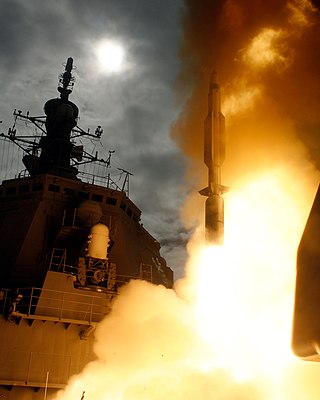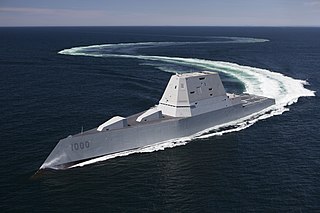
A cruiser is a type of warship. Modern cruisers are generally the largest ships in a fleet after aircraft carriers and amphibious assault ships, and can usually perform several roles.

The Oliver Hazard Perry class is a class of guided-missile frigates named after U.S. Commodore Oliver Hazard Perry, the hero of the naval Battle of Lake Erie. Also known as the Perry or FFG-7 class, the warships were designed in the United States in the mid-1970s as general-purpose escort vessels inexpensive enough to be bought in large numbers to replace World War II-era destroyers and complement 1960s-era Knox-class frigates.

The Arleigh Burke class of guided-missile destroyers (DDGs) is a United States Navy class of destroyer built around the Aegis Combat System and the SPY-1D multi-function passive electronically scanned array radar. The class is named for Admiral Arleigh Burke, an American destroyer officer in World War II and later Chief of Naval Operations. The lead ship, USS Arleigh Burke, was commissioned during Admiral Burke's lifetime.

A guided-missile destroyer (DDG) is a destroyer whose primary armament is guided missiles so they can provide anti-aircraft warfare screening for the fleet. The NATO standard designation for these vessels is DDG, while destroyers which have a primary gun armament and/or a small number of anti-aircraft missiles sufficient only for point-defense are designated DD. Nations vary in their use of destroyer D designation in their hull pennant numbering, either prefixing or dropping it altogether.

USS Farragut (DLG-6/DDG-37) was the lead ship of her class of guided-missile destroyers built for the United States Navy during the 1950s.

The Spruance-class destroyer was developed by the United States to replace the many World War II–built Allen M. Sumner- and Gearing-class destroyers, and was the primary destroyer built for the U.S. Navy during the 1970s and 1980s. It was named in honor of United States Navy Admiral Raymond A. Spruance, who successfully led major naval battles in the Asiatic-Pacific Theater during World War II such as the Battle of Midway and the Battle of the Philippine Sea.

The third USS Luce (DLG-7/DDG-38) was Farragut-class guided missile destroyer of the United States Navy that served from 1962 until discarded in 1992. The ship was named for Rear Admiral Stephen B. Luce (1827–1917). Luce was sold for scrapping in 2005.

The Zumwalt-class destroyer is a class of three United States Navy guided-missile destroyers designed as multi-mission stealth ships with a focus on land attack. It is a multi-role class that was designed with a primary role of naval gunfire support and secondary roles of surface warfare and anti-aircraft warfare. The class design emerged from the DD-21 "land attack destroyer" program as "DD(X)" and was intended to take the role of battleships in meeting a congressional mandate for naval fire support. The ship is designed around its two Advanced Gun Systems (AGS), turrets with 920 round magazines, and unique Long Range Land Attack Projectile (LRLAP) ammunition. LRLAP procurement was canceled, rendering the guns unusable, so the Navy re-purposed the ships for surface warfare. Starting in 2023, the Navy will remove the AGS from the ships and replace them with hypersonic missiles.
A destroyer squadron is a naval squadron or flotilla usually consisting of destroyers rather than other types of vessel. In some navies other vessels, such as frigates, may be included. In English the word "squadron" tends to be used for larger and "flotilla" for smaller vessels; both may be used for destroyer units. Similar formations are used in non-English-speaking countries, e.g., the "escadrille"—which would translate directly as "squadron"—in France.

The United States Navy reclassified many of its surface vessels in 1975, changing terminology and hull classification symbols for cruisers, frigates, and ocean escorts.
The name Mahan was assigned to the following four United States Navy ships, in honor of Rear Admiral Alfred Thayer Mahan, naval historian and theorist on sea power.

USS King (DL-10/DLG-10/DDG-41) was a Farragut-class guided missile destroyer in the United States Navy. She was named for Fleet Admiral Ernest Joseph King (1878–1956),

USS Coontz (DLG-9/DDG-40) was a Farragut-class destroyer leader/frigate in the United States Navy. She was named after Admiral Robert Coontz, the US Navy's second chief of naval operations.

The Farragut-class destroyer was a group of 10 guided-missile destroyers built for the United States Navy (USN) during the 1950s. They were the second destroyer class to be named for Admiral David Farragut. The class is sometimes referred to as the Coontz class, since Coontz was first to be designed and built as a guided-missile ship, whereas the previous three ships were designed as all-gun units and converted later. The class was originally envisioned as a Destroyer Leader class, but was reclassified as Guided-Missile Destroyers following the 1975 ship reclassification.

USS Macdonough (DLG-8/DDG-39) was a Farragut-class guided missile destroyer in the United States Navy. She was named for Commodore Thomas Macdonough, the 4th ship of the United States Navy to be named for him.

USS Zumwalt (DDG-1000) is a guided missile destroyer of the United States Navy. She is the lead ship of the Zumwalt class and the first ship to be named after Admiral Elmo Zumwalt. Zumwalt has stealth capabilities, having a radar cross-section similar to a fishing boat despite her large size. On 7 December 2015, Zumwalt began her sea trial preparatory to joining the Pacific Fleet. The ship was commissioned in Baltimore on 15 October 2016. Her home port is San Diego, California.

USS Dahlgren (DLG-12/DDG-43) was the 7th ship in the Farragut-class guided missile destroyer in the United States Navy. She was launched on 16 March 1960 by Philadelphia Naval Shipyard and sponsored by Mrs. Katharine D. Cromwell, granddaughter of Rear Admiral John Adolphus Dahlgren. She was commissioned on 8 April 1961. She was the third ship in the Navy to bear the name. Commissioned as DLG-12, Dahlgren was reclassified a guided missile destroyer on July 1, 1975 and given the new hull number DDG-43. The ship saw service until 1992, when she was placed in reserve. She was sold for scrapping three times, the first time in 1994, but was repossessed twice as the ship breaking companies failed. The ship was finally dismantled in 2006.

The DDG(X) program, also known as the Next-Generation Guided-Missile Destroyer program, is a United States Navy program to develop a class of surface combatant vessels to succeed its 22 Flight II Ticonderoga-class cruisers and 27 Flight I/II Arleigh Burke-class destroyers. The program is the culmination of the Large Surface Combatant (LSC) initiative that followed the cancellation of CG(X) and curtailing of the procurement of the Zumwalt-class destroyer. The ships will become the principal large surface combatants of the U.S. Navy; compared to their predecessors, they will incorporate more powerful sensors and have more room and weight margin for growth.

















